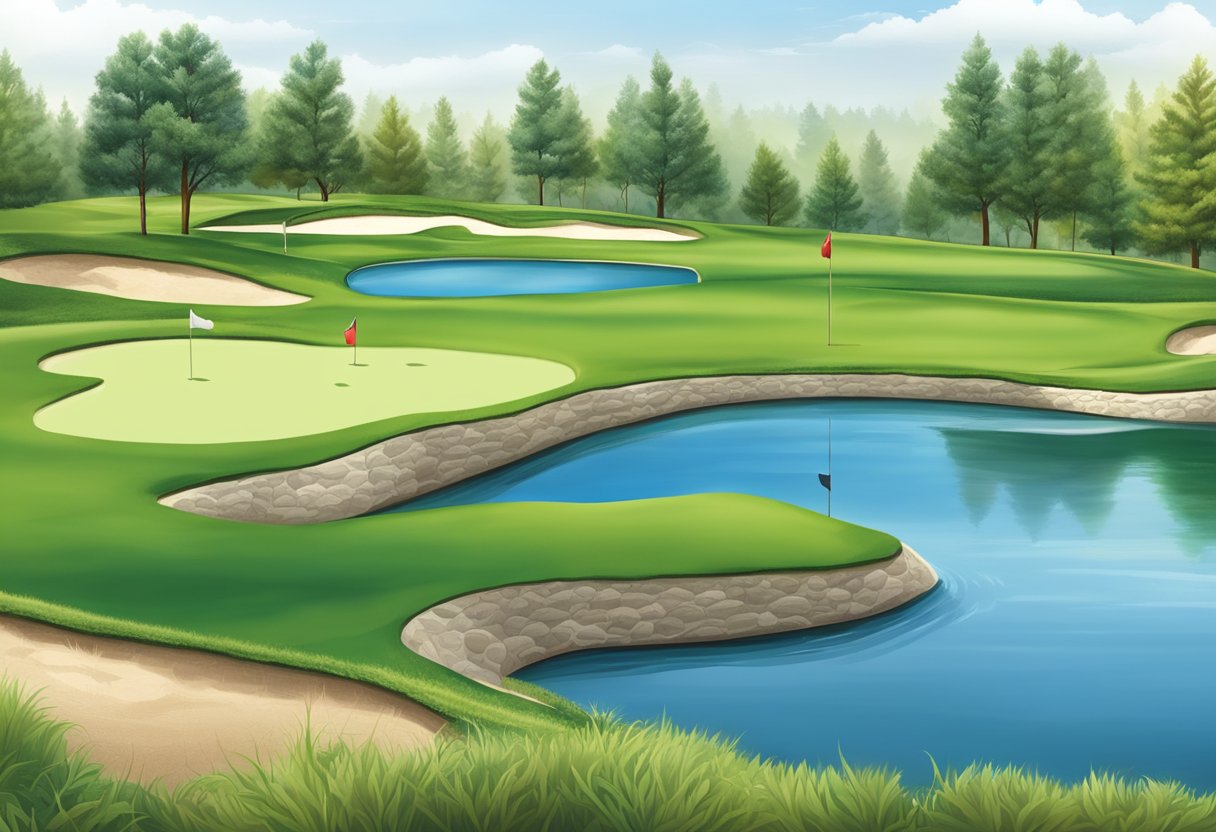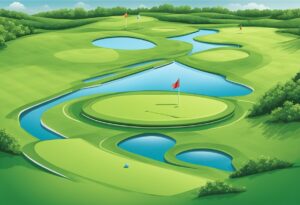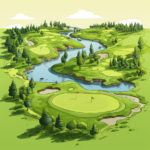The course rating is a difficulty level used by professional players and tournaments, whereas slope is a difficulty metric recreational golfers use. The United States Golf Association (USGA) developed the course rating and slope system to help golfers quickly understand the difficulty level of prospective golf courses.
The key to enjoying a game of golf is knowing you will be challenged without getting frustrated. For beginners, playing on a professional-level course will bring nothing but frustration. For experienced golfers, par-3 and beginner-level courses are likely too boring to enjoy. Because of this, course rating and slope systems were created to help standardize the difficulty levels of courses throughout the United States.
The course rating is a numerical value that determines the difficulty of a golf course for skilled golfers, also known as scratch golfers, who typically play at a professional level. This rating takes into account factors like course length, obstacles, and weather conditions. On the other hand, the slope rating evaluates the difficulty level of a golf course specifically for average, recreational golfers, often referred to as bogey golfers. By utilizing the course and slope ratings, golfers of different skill levels can better understand a particular course’s challenges, allowing for more informed decisions when choosing where to play.
Key Takeaways
- Course rating measures the difficulty of a golf course for highly skilled & professional golfers
- Slope rating assesses the difficulty for average, recreational golfers
- These ratings help golfers of all skill levels understand a course’s challenges
What is a course rating & how is it calculated?

A course rating is a numerical value that represents the difficulty of a golf course for a scratch golfer (player with a handicap of 0). It is calculated by the United States Golf Association (USGA) using various factors, such as yardage, hazards, and course design. Unless you are watching professional golf or an extremely advanced player, you should worry more about the slop rating.
What are the ranges of USGA course ratings?
USGA course ratings typically range from 67 to 77, representing the number of strokes it would take for a scratch golfer to complete the course. Lower ratings indicate easier courses, while higher ratings are considered more challenging.
As hobbyist golfers, we can tell you that 95% of people should stick to the slope rating unless you are watching professional golf.
What is a slope rating in golf & how is it calculated?
A slope rating in golf is a measure used by the United States Golf Association (USGA) to indicate the relative difficulty of a course for a bogey golfer compared to a scratch golfer. The higher the slope rating, the more challenging the course is for a higher handicap player.
To calculate the slope rating, you first determine the bogey course rating and scratch course rating of the golf course. Then, subtract the scratch course rating from the bogey course rating, and multiply the difference by 113 (the slope rating of a golf course of standard difficulty). Finally, divide the result by the average difference in the ratings between a scratch golfer and a bogey golfer. This provides us with the golf course’s slope rating.
We recommend that golfers with higher handicaps pay close attention to the slope rating when selecting a course. This will help you find the most suitable courses for your skill level, ensuring you pick a course you where you can play a competitive round of golf.
What are the ranges of slope ratings?
Slope ratings typically range from 55 to 155, with a value of 113 representing a standard or average difficulty golf course. Lower values imply an easier course, while higher values indicate a challenging one for golfers.
When was slope rating adopted by the USGA?
The United States Golf Association (USGA) adopted the slope rating system in 1986. This system was created to provide a more accurate measurement of course difficulty, helping standardize difficulty ratings nationwide.
Does slope rating only apply to bogey golfers?
While the slope rating system was initially designed for bogey golfers, it has since evolved and is now applicable to golfers of all skill levels. By considering numerous variables, including course layout, hazards, and difficulty, the slope rating offers a fair evaluation of a course’s difficulty, which can be helpful for players when determining which courses best suit their abilities and skill level.
What are Scratch and Bogey Golfers?
A scratch golfer is a player who can play to a handicap of zero on any rated golf course. A bogey golfer regularly scores around 18-20 strokes above the course par. In this section, we will discuss the differences between these types of golfers and how the rating system affects their game.
Scratch Golfer
A scratch golfer is considered an expert player and typically has a firm understanding of the game. Male scratch golfers can typically hit the ball 250 yards or further. These players understand the nuances of various obstacles and course features.
Bogey Golfer
A bogey golfer, on the other hand, doesn’t have the same level of expertise as a scratch golfer. Bogey golfers may struggle with navigating hazards, bunkers, and rough terrain. They generally don’t hit the ball as far as scratch players, and their scores tend to be higher.
Rating System and Factors Affecting it
The course rating system, designed by the United States Golf Association (USGA), evaluates the difficulty of a golf course based on factors such as topography, effective playing length, and various obstacles. USGA course raters measure these variables to determine the course’s relative difficulty for scratch and bogey golfers.
The Effect of Course Topography
Topography plays a crucial role in determining a golf course’s difficulty rating. Elevation changes, altitude variations, hazards, and differences from sea level all contribute to a course’s overall difficulty rating.
How the Length of Play Impacts Rating
The yardage of a course directly impacts its difficulty and rating. Longer courses generally require more skill from players, as they must hit the ball farther and more accurately to achieve desirable scores.
Handicaps and Their Importance
A player’s handicap index helps level the playing field between golfers of different skill levels so they are able to play together. A handicap represents a player’s potential ability in terms of strokes over or under par, with a lower handicap indicating a more skilled player.
How Rating Influences the Golfing Experience
The course rating and corresponding slope affect a player’s golfing experience by providing a clear indication of a course’s difficulty. This information helps golfers choose suitable courses, while also aiding in the adjustment of handicaps for fair competition.
The variables of the sport including course rating, topography, and handicaps, play a critical role in a player’s experience, enjoyment and overall success. Considering these factors when picking out a course, you’ll have a much more enjoyable time playing golf.
Frequently Asked Questions About Slop & Course Rating
A standard scratch score (SSS) measures a golf course’s difficulty for the “average golfer”. It’s primarily used in the United Kingdom and Ireland, and is based on the yardage and various obstacles present on a course. We use the SSS to compare golfer performance across different courses and conditions.
Slope rating is calculated by comparing the bogey rating (score for a bogey golfer) to the course rating (score for a scratch golfer) and course length. The higher the slope rating, the more difficult the course is for a bogey golfer in relation to a scratch golfer. The United States Golf Association (USGA) provides a detailed guide on the calculation process.
A course’s rating is an estimate of the average score a scratch golfer (a golfer with a handicap of zero) would perform on a given course. It takes into account factors such as yardage, green size, and hazards. Slope rating, on the other hand, measures the relative difficulty of the course for bogey golfers (handicap of about 20 for men, 24 for women) as compared to scratch golfers. These two numbers are used together to determine a golfer’s course handicap.
A slope rating above 130 signifies that the course is more difficult for bogey golfers than the average course in the United States. The USGA’s slope rating scale ranges from 55 to 155, with 113 being the average slope. As the slope rating increases, it indicates a greater disparity in difficulty between scratch and bogey golfers.
Some of the highest slope ratings include the Ocean Course at Kiawah Island, Whistling Straits, and Bethpage Black. These courses are known for their challenging layouts, high winds, and other factors that increase the overall difficulty, especially for bogey golfers. If you are a beginner, we highly recommend picking easier courses.
Yes, a slope rating of 135 is considered difficult. As we mentioned earlier, the average slope rating is 113, so a 135 indicates that the course will be more challenging for bogey golfers than a course with an average slope rating. Higher slope ratings typically mean that a bogey golfer’s handicap will have a greater impact on their final score, making it more difficult game for them.







